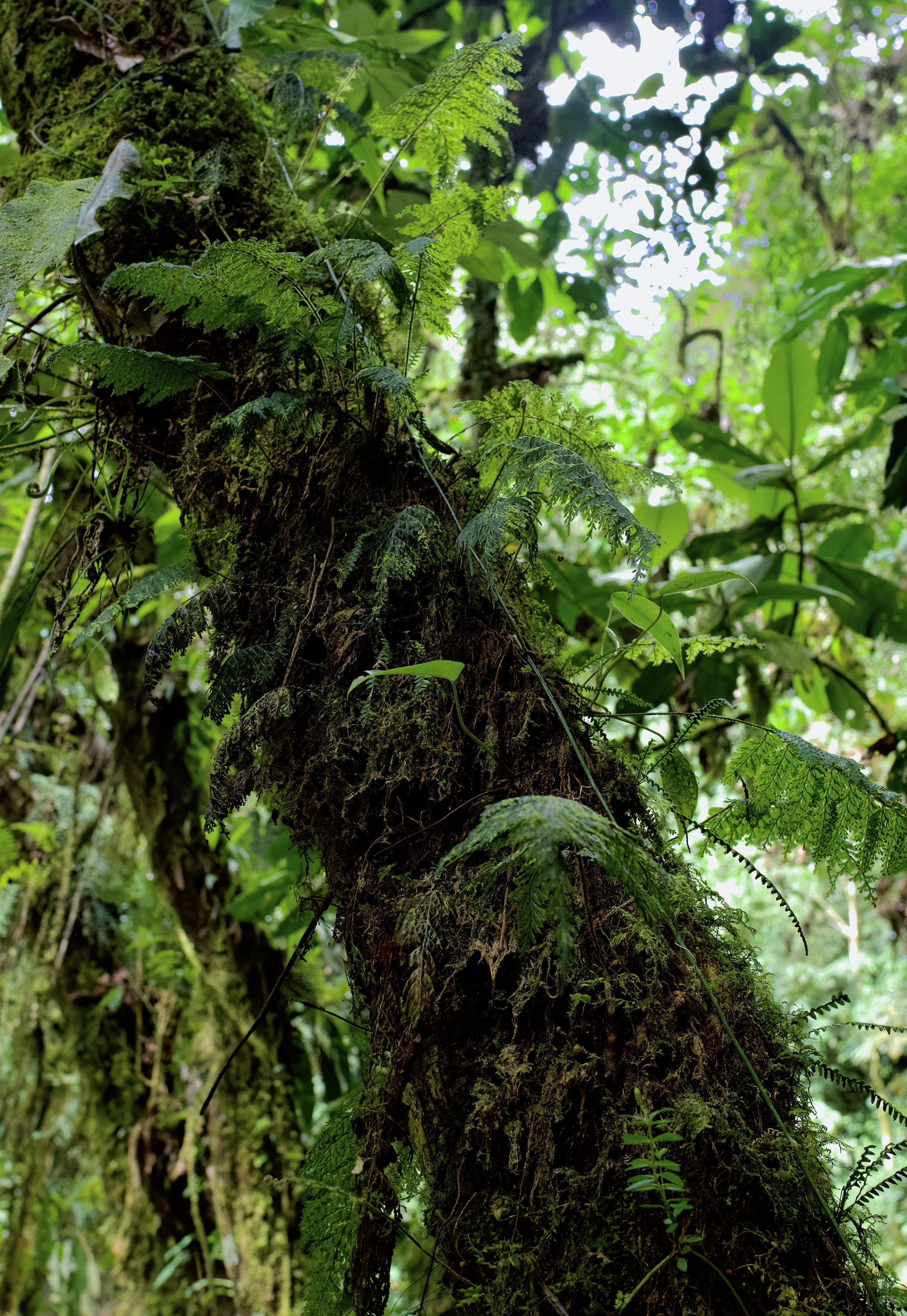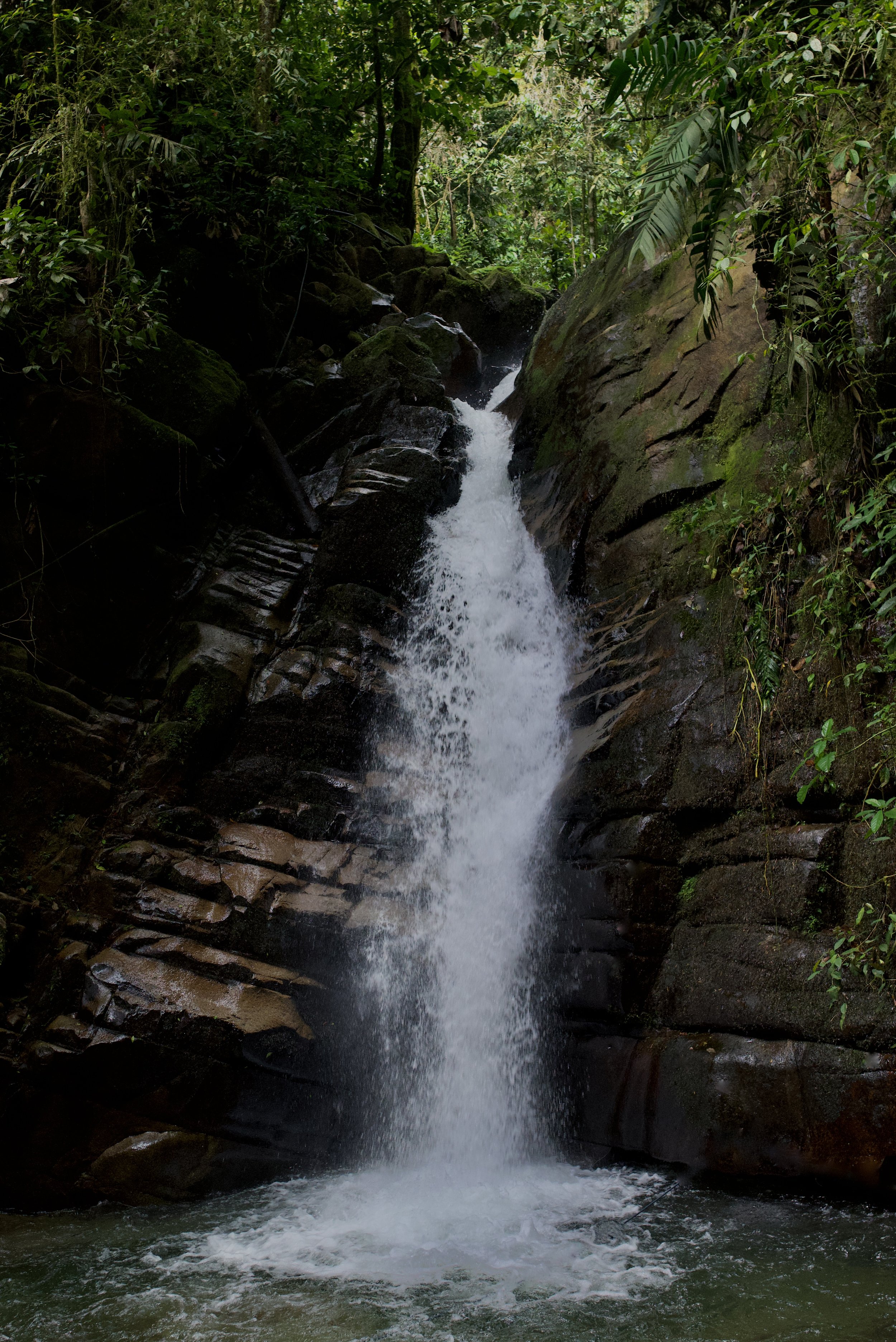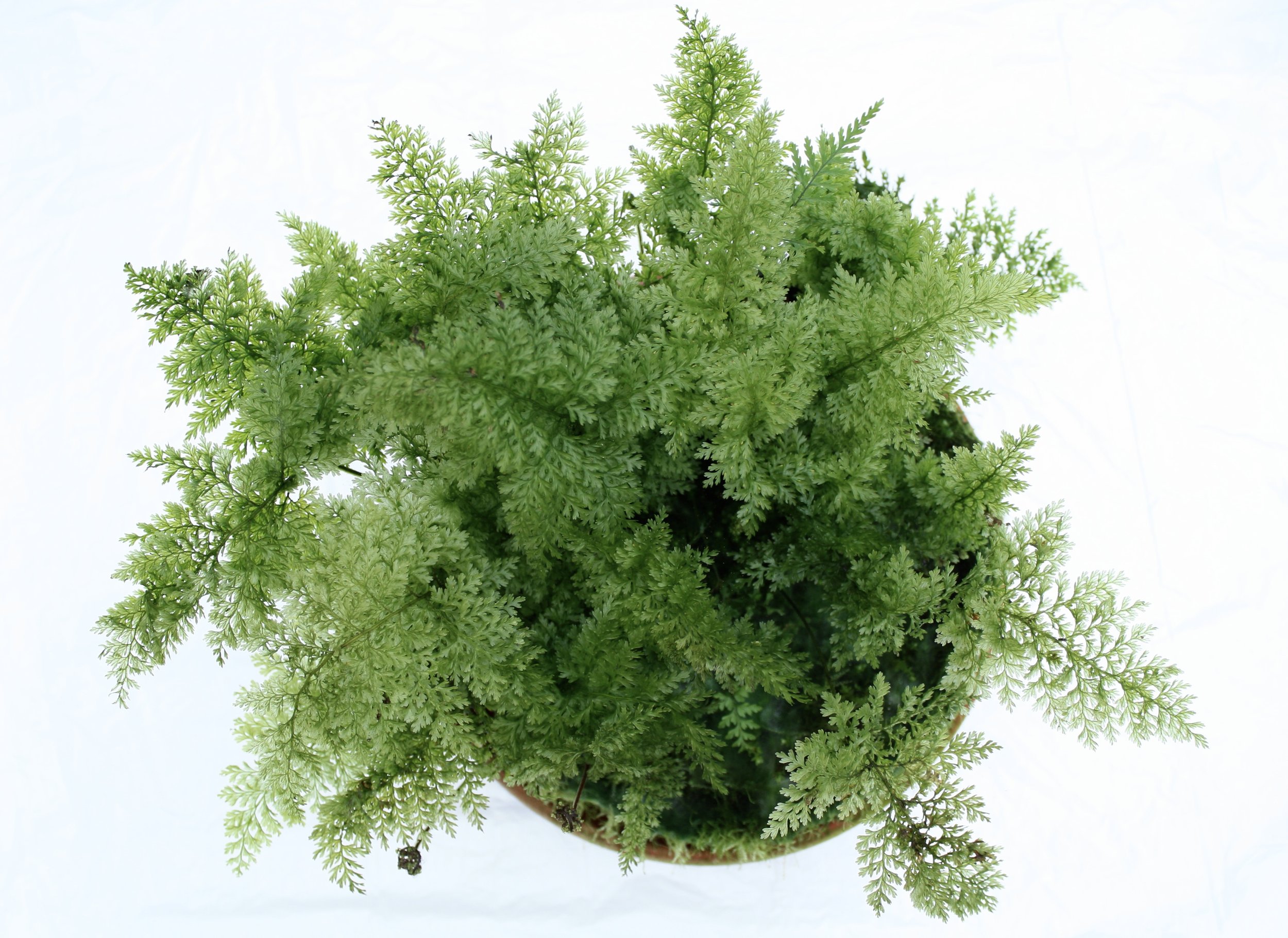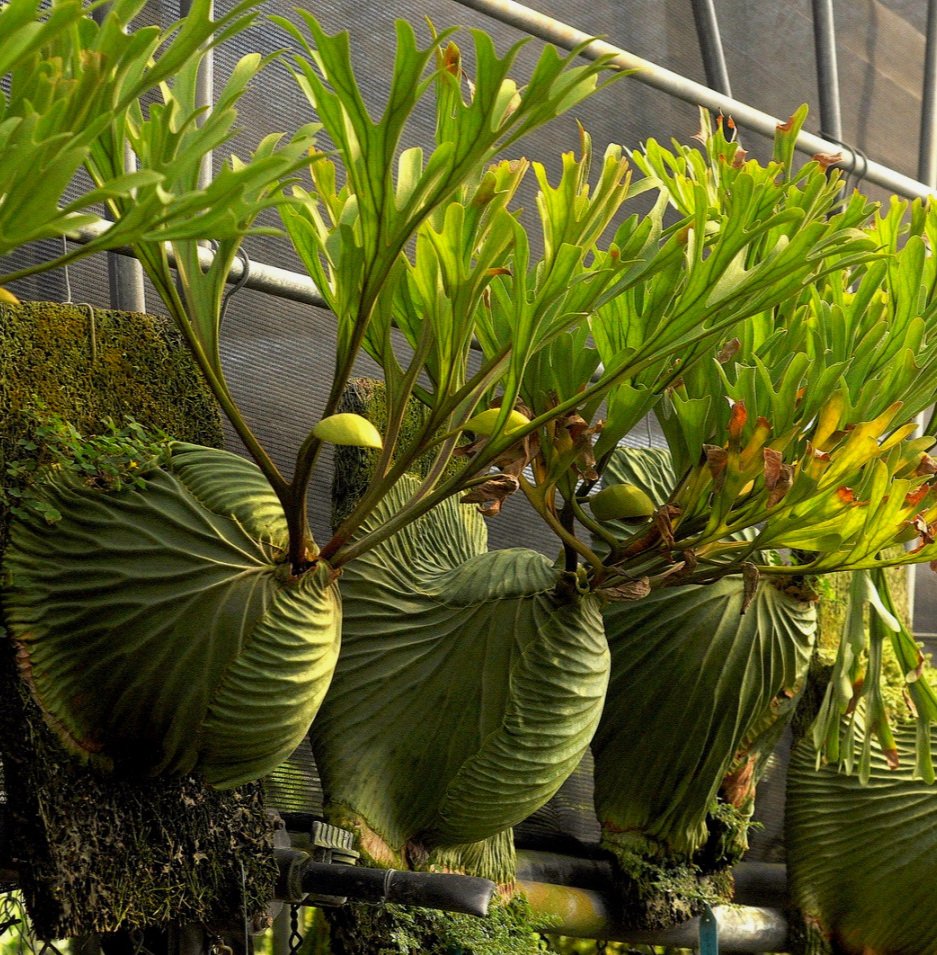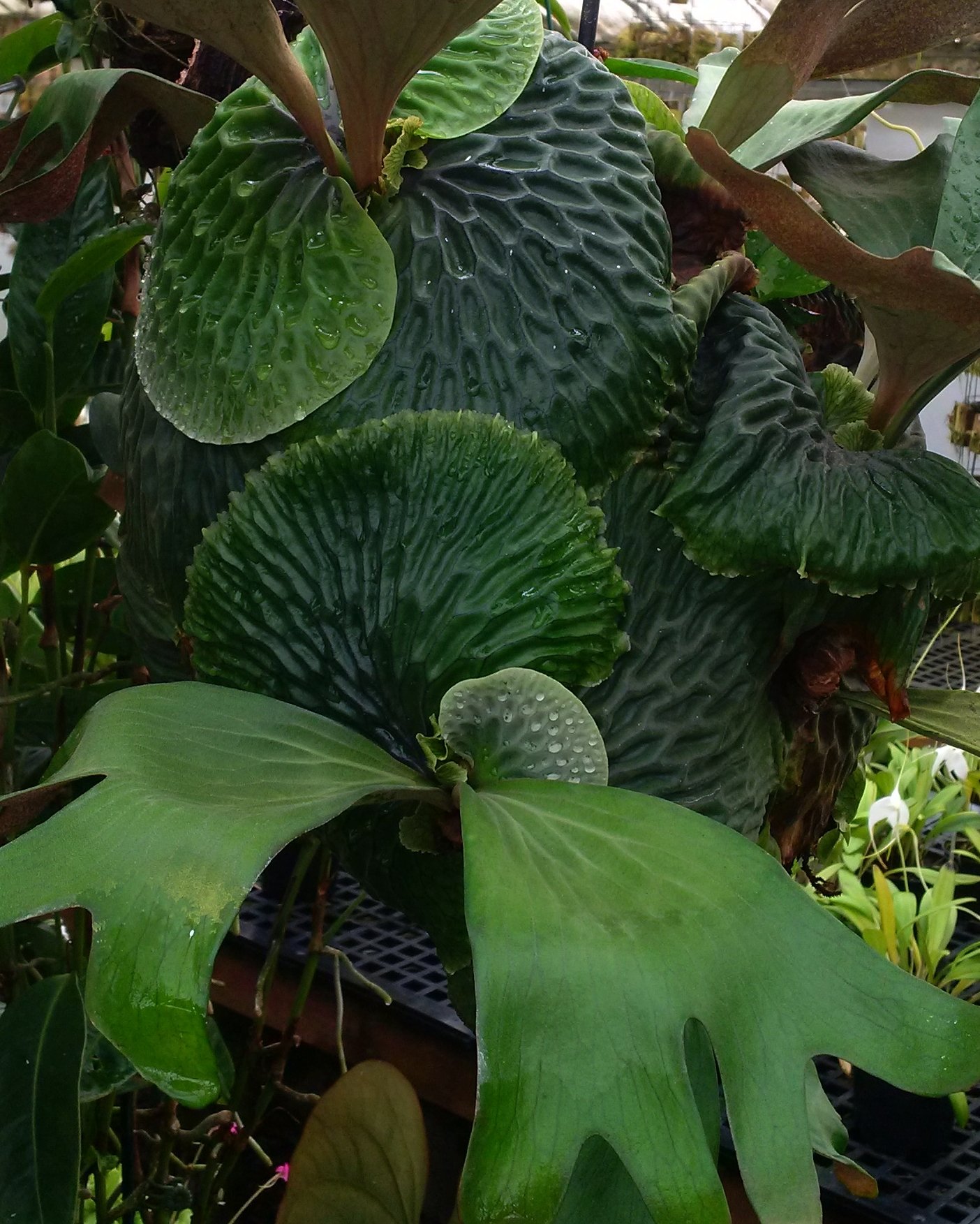Tropical Filmy Ferns in Nature & Cultivation
The Real Skinny
by Jay Vannini
Backlit Hymenophyllum sp. in nature showing round sori dotting the frond margins. Huánuco Department, Perú. Image: ©Fred Muller 2024.
What are commonly referred to as filmy ferns are tiny (~0.20”/5 mm) to mostly small (<24”/60 cm frond lengths), solitary, colonial, or mat-forming ferns with membranous fronds that lack stomata. They occur in a variety of moisture-saturated temperate and subtropical environments, tropical cloud forests, and rainforests around the world but are most diverse in the Neotropics and the Indomalayan Realm. Despite claims that the leaves of all filmy ferns are only a single cell deep – as is indeed the case in Trichomanes subgenus Trichomanes – this is apparently not the case for many members of the family (Ebihara et al., 2006; pers obs. with examples shown below). The interveinal leaf tissue on newly emerged fronds of those species that are only one or a pair of cells deep are noticeably transparent or translucent even in the shade. In many others the interveinal leaf tissue is a few or more cells deep (e.g., in the well-known, blue iridescent Trichomanes elegans) and the fronds are translucent in these species only when backlit.
A Killarney bristle fern, Trichomanes speciosum, colony growing adjacent to a waterfall on São Miguel Island, Azores. Filmy ferns thrive in these sheltered, saturated environments. Image: ©Clive Lundquist 2024.
Often abundant in heavily shaded niches such as moss covered tree trunks and limbs in the understory, in gullies, crevices and on rocks at the mouths of caves and grottos, as well as partially submerged or thriving in the spray zone of streams and cascades. A cursory inspection of mossy rocks and branches located adjacent to cloud forest and montane rainforest streams in the Neotropics often reveals one or more filmy fern species. Several aberrant species, such as Trichomanes tuerckheimii, grow as hemiepiphytic shingle plants with broad, overlapping fronds adpressed to tree trunks or rock faces. They can represent a significant percentage of the overall fern flora in some areas. At middle elevation cloud forests in and adjacent to the Quetzal Biotope, a biodiversity-rich protected area in central Guatemala, filmy ferns (both genera, 14 species) comprise 11% of all native fern species (Jímenez Barrios, 2010). Similar results were published in a survey of filmy fern diversity in eastern Brunei, where a whopping 22 species of Hymenophyllaceae were collected at a single small, lowland forest research station there (Popelka et al., 2018).
The fragile, sometimes ethereal appearance of filmy ferns invariably attracts comment by botanists and nature writers who come across wild populations for the first time (Chanter, 1856, Sacks, 2012; Tchou, 2019). They also have an almost magnetic attraction for wild plant photographers wherever they occur.
Tropical filmy ferns are considered to be among the most challenging plants kept in ornamental horticulture, and their rarity in collections world-wide only adds to their appeal. Based on my review of botanical and garden literature spanning almost two centuries, the consensus is that “filmies”, as they are sometimes called in contemporary horticulture, are attractive and interesting plants both in nature as well as captivity.
An elfin colony of Hymenophyllum dentatum, a showy miniature temperate filmy fern growing on mossy rocks in Queulat National Park, Aysén Region, Chile. Image: ©Clive Lundquist 2024.
Filmy ferns in the strict sense are evergreen ferns in the family Hymenophyllaceae and include two Cosmopolitan genera; the Membranous Filmy Ferns (Hymenophyllum Sm.– 305 species), and the Bristle Ferns (Trichomanes L. – 253 species) (Plants of the World Online, 2024). They are characterized by having wiry or slender, mostly scale-less rhizomes, thin leaf tissue that lack stomata, and having immersed marginal sori with either bivalvate (clamshell) or narrow tubular to infundibular (funnel-shaped) indusia and elongated receptacles in sporing examples.
Formerly recognized minor genera sunk into synonymy with Trichomanes in 2019 include Abrodictyum, Callistopteris, Cardiomanes, Cephalomanes, Crepidomanes, Didymoglossum, Polyphlebium, and Vandenboschia (Ebihara et al., 2006; Shankar & Srivastava, 2019; Plants of the World Online/POWO, 2024). This wholesale discard of the complex taxonomic arrangement proposed by Ebihara and his coauthors by sinking them all into two genera remains a controversial move that is not universally accepted by pteridologists. My admittedly selfish view is that it greatly simplifies generic identification of plants for amateur botanists who encounter them in the field, so all to the good from my side! An internet search of these ferns will reveal continued use of some the generic names listed above, especially Crepidomanes and Vandenboschia (e.g., Ferns and Lycophytes of the World Online, 2024). Alternate generic names are shown in this article in parentheses.
As this hodge-podge of disputed generic names indicates, filmy fern species are sometimes maddeningly variable within populations and challenging to identify with certainty when young, even by fern specialists (pers. obs.). The fact some mat-forming and colonial species (e.g., Hymenophyllum wrightii and Trichomanes speciosum) have polymorphic, geographically discrete populations where one exists only as gametophytes while the other develops conventional-looking sporophytes/mature fronds only add to the challenges in their identification (Kingston & Hayes, 2005; Ebihara et al., 2008). A few mostly tropical species (e.g., T. diversifrons) have dimorphic sterile and fertile fronds.
A mass of tiny fronds of Hymenophyllum sp. cf. abruptum growing as a colonial rheophyte on the sides of a boulder in a fast running cloud forest stream, San José Province, Costa Rica. These miniature filmy ferns survive periodic submersion when the stream level fluctuates during heavy rains. Image: ©Jay Vannini 2024.
At the risk of boring the reader with minutiae, for one random example of the confusion that has reigned in filmy fern taxonomics for almost two centuries, I’ve included a list of synonyms for the widespread Indomalayan species, Trichomanes auriculatum Blume. This name has gone full circle as an accepted binomial since its original description in 1828. These have included alternate generic placements such as Vandenboschia auriculata (Blume) Copel. [1938], Cephalomanes auriculatum (Blume) Bosch [1859], Lacosteopsis auriculata (Blume) Nakaike [1975], and Crepidomanes auriculatum (Blume) K. Iwats. [1985-still accepted as the valid name by Tropicos]. Besides these confusing shell games with generic names, the following binomials have been sunk into synonomy with T. auriculatum in the recent past: T. belangeri Bory 1975, T. dimidiatum C. Presl.1975, T. dissectum J. Sm. 1975, and Vandenboschia hainensis Ching & P. S. Chiu 1959.
Trichomanes sp. growing together with Elaphoglossum peltatum as branch epiphytes overhanging a stream bank in southeastern Costa Rica. Image: ©Jay Vannnini 2024.
The key morphological characters selected by botanists to defend more than two genera may need refining. Tools used in molecular taxonomy have been employed for correcting generic placement of even well-known temperate filmies such as the kidney fern. This interesting small filmy with reniform fronds, endemic to New Zealand, has bounced between placement in Cardiomanes (as C. reniforme (G. Forst.) C. Presl), Trichomanes (as T. reniforme G. Forst.) and Hymenophyllum (as H. nephrophyllum Ebihara & K. Iwats.) over past decades. And again, dueling opinions between the taxonomic gatekeepers for Missouri BG’s Tropicos and RBG Kew’s Plants of the World Online currently recognize two different generic names as accepted taxa (Tropicos, 2024; Plants of the World Online, 2024).
Given the vast distributions ascribed to many individual species of filmy ferns, coupled with recent taxonomic flux, their often cryptic habit, and newly documented diversity in poorly botanized regions of megadiversity countries, it is highly likely that the family contains many more species than are currently recognized (Popelka et al., 2018).
While filmy ferns occur discontinuously throughout sheltered, moisture-saturated microclimates in many regions of the Northern Hemisphere, they are most diverse in the wet Neotropics and the Indomalayan Realm as well as subtropical regions of the southern hemisphere, especially in Chile and New Zealand. Filmy ferns are well-represented on most of the world’s major island chains.
Four species occur locally across Britain and the EU, with one Madeiran endemic (Hymenophyllum maderense) listed as Critically Endangered by the IUCN (IUCN, 2017). Other legally protected filmy fern species in the EU and U.S., including the widespread Killarney bristle fern (Trichomanes speciosum), the localized Florida filmy fern (T. punctatum subsp. floridianum), and the Caribbean lined filmy fern (T. lineolatum; possibly extirpated in its US range) are the subjects of national conservation and restoration plans. Occasional poaching of threatened filmy fern populations remains a matter of concern, especially in the UK (Dyer et al., 2002). Habitat alteration and climate dynamics are also a threat.
Filmy ferns have a long and storied history in ornamental horticulture (Lowe, 1865). Tropical introductions are not a recent phenomenon, despite having apparently vanished from greenhouses during the early 20th century until recently. Temperate forms have fared somewhat better in British collections. The cosmopolitan Tunbridge filmy fern (Hymenophyllum tunbrigense) may have been the first species to be successfully cultivated under glass in the UK during the Victorian Fern Craze. Rickards (2000) mentions a naturalized, Australian origin Trichomanes venosum grown in an artificial grotto in Cornwall as being as much as a hundred years-old, so at least some subtropical species can thrive long-term in the climate of coastal southwest England. The handsome European and mid-Atlantic Killarney bristle fern (T. speciosum) was also a very popular subject for early fern collectors in England and elsewhere. This species remains the most widely cultivated filmy fern species in research collections to this day (PlantSearch, 2024).
Tropical filmy ferns were painted from life by several celebrated British botanical illustrators in the 19th century. Shown here, Trichomanes bancroftii from Brazil, Venezuela, and the Lesser Antilles drawn by Walter Hood Fitch. Fitch was considered one of the best plant illustrators of his time and his work appeared on a regular basis in Kew Gardens’ publications and Curtis’ Botanical Magazine. This plate was included in Sir William Jackson Hooker’s “Garden Ferns; or Coloured Figures and Descriptions… (1862). Plate from the author’s collection. Image: ©Jay Vannini 2024.
The first successful transoceanic use of the Wardian Case in 1833 (with British ferns among the test subjects) greatly increased the number of delicate tropical ferns available to 19th and early 20th century collectors, including some filmies (Abbey, 1867; Veitch, 1906; Allen, 1969). Ornamental Wardian Case designs were also used for permanent display of rare ferns in homes from the mid-1800s into the contemporary era (Lowe, 1865; pers. obs.).
Victorian fern fanciers often went to great lengths to provide near-optimum conditions for their filmy fern collections. Besides constructing dedicated filmy fern houses/ferneries in both private and public gardens, clever hardscape designs and water features also produced deeply shaded or even underground fern grottos on the properties of the great estates where these plants were grown. Some dedicated filmy fern houses survived until recently (e.g., at the Orangery at Kew; Furse-Roberts, 2005); the foundations of others have been unearthed at restorations of celebrated older gardens (Lawrence, 2017). Perhaps one of the oldest specimens still surviving under glass in a British collection is the large specimen of Killarney bristle fern housed in a Wardian Case in the Cool Fernery at the Chelsea Physic Garden (C. Lundquist, pers. comm.). Rickards (2000) observed that some members of the British Pteridological Society are recreating these structures in their own gardens.
The Victorian Era and Beyond
Native and exotic filmy fern cultivation reached its apogee in Britain during the second half of the 19th century and in the opening years of the last.
The well-known Victorian Era British passion for fern collecting, especially among women, was wryly given its own term by Church of England intellectual, social reformer, and naturalist, Charles Kingsley:
“Pteridomania”.
“Your daughters, perhaps, have been seized with the prevailing 'Pteridomania' ... and are collecting and buying ferns…and wrangling over unpronounceable names of species (which seem different in each new Fern-book that they buy) till the Pteridomania seems to you somewhat of a bore; and yet you cannot deny that they find enjoyment in it, and are more active, more cheerful, more self-forgetful over it, than they would have been over novels and gossip, crochet and Berlin-wool” (Kingsley, 1855).
Kingsley’s gifted younger sister Charlotte Chanter was herself afflicted with “fern madness” so he was somewhat of an authority of the subject. Chanter authored a very popular book on wild fern collecting that went into several printings in rapid succession. She discusses filmy ferns in her chatty “Little Book” and was an early advocate of people digging up populations of ferns from nature, an activity later prohibited in at least one English county as early as 1904 and illegal or frowned upon today in many countries (Chanter, 1856; Anon.,1904; Dyer et al., 2002; pers. obs.).
Pteridomania is an interesting topic for gardeners in its own right and several books and online articles have been published about its influence on British society in the 19th century. For those interested, I strongly recommend David Elliston Allen’s short but well-researched, “The Victorian Fern Craze” (1969) as the best of breed.
A widely reproduced image published in The London Illustrated Daily News’ “Every Saturday” section in July 1871 that shows an outing of well-dressed fern collectors combing the hillside and gathering basketfuls of swag for their gardens. The accompanying text – extolling “Cryptogamic vegetation” – closes with a nudge and wink, stating, “The engraving we print on page 100 represents a party gathering ferns, an occupation which does not, it would appear, preclude the possibility of having a little quiet flirtation.” Note the narrow, specialized fern trowel held by the well-bustled lady shown center. Well-conserved examples of antique British fern trowels are now considered collectibles. Plate from author’s collection. Image: ©Jay Vannini 2024.
An advertisement for filmy ferns by specialty nursery J. Backhouse & Son Ltd. from 1905. This nursery, founded in 1815 by James Backhouse father and later managed by his son James the second, was a well-known English source for tropical filmy ferns during the Victorian Era. Image in the public domain.
Besides discussing two dozen cool and temperate-origin filmy fern species suitable for cultivation in unheated glasshouses, together with three small Todea species (Osmundaceae), British fern specialist George Abbey (1867) listed as suitable for Stove (a warm greenhouse) many Trichomanes (30 species) and several Hymenophyllum (seven species). Cool origin filmies included in his descriptions mostly originated from Chile, New Zealand, and Europe, while the tropical species are described as having West Indian, Mauritian, and Javan/Bornean origins. Rather surprisingly considering the paucity of current offerings, mid-19th century British fern collectors had access to at least 50 species of filmy ferns, many of which would now be considered rare and desirable miniature “exotics”. For a modern comparison, a review of Botanic Gardens Conservation International’s (BGCI) PlantSearch database revealed that only 45 species of filmy ferns are currently held globally in ca. 1,100 ex-situ member collections (PlantSearch, 2024).
In private hands, the family has recently developed a small but dedicated following.
As is the case for many other desirable miniature ornamental plants, it was the poison frog (Dendrobatidae and Mantellidae) collecting community that re-sparked interest and availability of tropical filmy ferns in the late 1990s (pers. obs.). Small fern species in general are desirable décor items for humidity-saturated vivaria, and filmies are invariably common where poison frogs occur in tropical America and Madagascar. Largely because of this, recent initiatives to grow tropical filmies invariably recommend them exclusively as candidates for closed or flooded containers, such as terraria, paludaria, or aquaria. They certainly excel in wet terraria and vivaria with either permanent water features or intermittent fine mist of pure water.
Worth noting is that northern gardeners have lumped several quite unrelated “lookalike” ferns under this catchall common name. These include some crepe ferns (Leptopteris species - Osmundaceae), hard ferns (Blechnum species - Blechnaceae), dwarf thread ferns (Grammitis/formerly Cochlidium species - Polypodiaceae), as well as certain miniature spleenworts (Asplenium and Hymenasplenium species. - Aspleniaceae). All these plants are far easier to source and cultivate than most members of the Hymenophyllaceae, hence the temptation to include them in the group. Images of some modern “filmy fern collections” posted online clearly show examples of other fern families mixed into plantings in enclosed ferneries.
Newly collected filmies intended for live studies should be transferred to small, sealed plastic bags or jars immediately after being removed from their mounts. They are fragile! My friend, University of San Carlos botanist Juan José Castillo and I were exploring the lower montane wet forests on the eastern slope of Volcán Santa María in Quezaltenango Department of Guatemala some years back in search of several locally endemic plants. During our hike we came across a small waterfall cascading down a vertical rock face, swirling in mist under dense tree canopy, whose banks were covered by many thousands of individuals of a small filmy fern species with transparent frond tissue. Plucking a few off the rocks for closer examination back at the truck I dropped them, soaking wet, into my shirt pocket.
Half an hour later when I retrieved them from my pocket, they were reduced to a small, sodden mass of pale green mush…
Hymenasplenium sp. (Aspleniaceae) growing drenched in a cataract in Oaxacan cloud forest. Many small tropical ferns can be confused with filmies on first contact. Image: ©Clive Lundquist 2024.
The translucency of fresh filmy fern fronds is one of their most appealing characteristics. Shown here, a cultivated, six year-old Trichomanes galeottii from central Panamá in the author’s collection. Trichomanes galeottii is an attractive and somewhat variable Mesoamerican and Colombian filmy fern species that has outlier populations in Cuba and northern Ecuador. Specimen cultivated on a shady, open bench in a warm tropical greenhouse. Image: ©Jay Vannini 2024.
A tall (~10’/3.10 m) hemiepiphytic Hymenophyllum sp. growing immediately adjacent to the montane stream and cascade shown on the right in western Colombian cloud forest. Compare with Clive Lundquist’s image taken in the Azores at the beginning of this article. Trapped mist and resultant saturated environments in these natural amphitheaters provide ideal conditions for filmy ferns and other delicate cryptogams. Images: ©Jay Vannini 2024.
Not a tropical filmy, but a beautiful temperate species from eastern North America, the Appalachian bristle fern, Trichomanes boschianum (Vandenboschia boschiana). This small species, shown here growing in a wet sandstone grotto in Ohio, is one of our most beautiful native ferns and is spottily distributed in many central and southeastern states. Image: ©Ron Parsons 2024.
A colony of Hymenophyllum sp. cf. microcarpum in high elevation cloud forest of the western Sierra de las Minas, central Guatemala. Image: ©Jorge Mario Vargas 2024.
Cultivation Guidelines
To set the tone of this section from the gitgo: Almost all tropical filmy ferns are challenging plants in cultivation. Well-grown specimens are few and far between in contemporary collections (PlantSearch, 2024; pers. obs.). There is good reason for this. Like almost all plant genera that require specialized environmental conditions and the frequent attention of gifted growers, they have tended to disappear from display and research collections of public gardens as priorities change and a “one-size-fits-all” approach to greenhouse management practices prevail…
Trichomanes elegans is a wide ranging Neotropical filmy fern with attractive, metallic or iridescent blue fronds. Pinnae shape is variable depending on the locality and size of the fern (see images below). The structural nature of its color has made it popular as a subject for researchers that study iridescence in plants. Image: ©Fred Muller 2024
Above: A leaf-perfect specimen of Killarney bristle fern, Trichomanes speciosum, grown in flooded Seramis (turface) by English iridescent plant researcher and horticulturist, Dr. Clive Lundquist. His garden cloche is shown right. Plant grown for study purposes from a division provided by the Chelsea Physic Garden. Note that all three species of native filmy ferns are protected in the UK and Ireland and may only be grown there from legally authorized plant sources. Images: ©Clive Lundquist 2024.
A colony of Hymenophyllum fucoides growing on a decomposing tree root on the forest floor in cloud forest, Baja Verapaz Department, Guatemala. Image: © Jay Vannini 2024.
A young Hymenophyllum sp. growing as an epiphyte on a mossy sapling in cloud forest understory, Risaralda Department, Colombia. Image: ©Jay Vannini 2024.
To continue reading the rest of this and other Premium Content articles, please subscribe to Esotérica Exclusiva.
Access to deeper dives and behind the scenes looks into advanced tropical horticultural practices as well as observations on fieldwork, plant collection management, and Neotropical wildlife.
Acknowledgements
Ecotour guide and plant explorer extraordinaire Fred Muller provided several superb portraits of filmy ferns in nature in Central and South America. Dr. Clive Lundquist kindly let me pick his brain on his experiences with these plants in nature as well as contemporary filmy fern cultivation in the UK. Clive also provided an image of his own Trichomanes speciosum in closed container cultivation at his home in England together with photos of beautiful wild filmy ferns in Chile and Azores, and a Hymenasplenium species in-situ in Oaxaca. Guatemalan botanist Jorge Mario Vargas shared an image of a colony of Hymenophyllum sp. growing in cloud forest there. Dr. Robbin Moran, Curator Emeritus of the New York Botanical Garden, very generously provided most of the identifications from images I sent, and also corrected a key mistake I had made prior to publication with an early determination. I am extremely grateful for his input. My friend Ron Parsons also provided a nice test shot of a sporing Panamanian filmy fern in my collection in California, together with a superb image of a colony of native filmies in Ohio, U.S. Notwithstanding an effort to put correct scientific names on everything shown herein, any misidentified images posted in the article are on me. Several anonymous sources have donated tropical filmy fern starts to my collection over the past decade.
Many thanks to all.
All content ©Exotica Esoterica® 2018-2024, ©Jay Vannini 2024, ©Clive Lundquist 2024, ©Fred Muller 2024, ©Ron Parsons 2024, and Jorge Mario Vargas 2024.
Follow us on:










